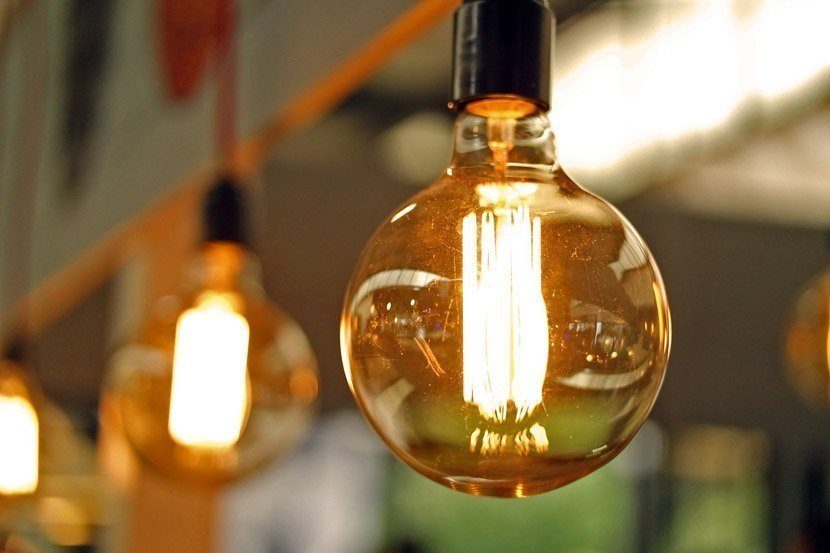
On January 27, 1880, Thomas Edison patented the electric incandescent lamp. The incandescent light bulb was invented by Thomas Alva Edison in the year 1879. Despite the fact that it was invented over one hundred years ago, the principle behind the design is still the same today as it was then.
How an Incandescent Light Bulb Works
The incandescent light bulb is a glass bulb with a metal wire inside. When the power is on, the light, of course, turns on. But what probably isn’t as obvious is the fact that the electricity that turns the light on isn’t directly producing the light. Instead, when power runs through the thin wire it encounters resistance. In overcoming this resistance heat is produced. In fact so much heat is produced that the filament glows white-hot — the light that you can see.
The Light Bulb Filament
To be practical the typical light bulb has to be able to last at least a few days. Therefore, a good filament must be chosen. The first practical light invented by Edison used a carbonized cotton-thread filament that lasted about thirteen hours and thirty minutes. After more experimenting, Edison found that carbonized bamboo was a better choice. Even though bamboo still lasted a very short amount of time by today’s standards, people back then were quite content with it. In about 1904, the robust tungsten filament incorporated into today’s bulbs was introduced.
The Vacuum

The material of the filament is not the only factor that affects the bulb’s life. The surrounding space is important, too. Edison discovered that to make a light bulb filament last longer it has to be in a vacuum; otherwise the filament will burn out quickly as the air oxidizes the filament at high temperature. Hence, the glass bulb’s function is not solely for the protection of the materials inside and the user outside, but also to hold the required vacuum. Today certain gases, such as krypton or argon, are sometimes used to extend the life of the filament by preventing it from vaporizing quickly from its own heat.
The Future
The incandescent light bulb originally invented by Edison hasn’t changed much over the years and remains a very practical way to produce light. However, as more efficient bulbs begin to replace it — those using less power to produce the same amount of light — it is quite possible that the incandescent light bulb will become a thing of the past.
Suggestions
(You’ll find resources helpful for completing these suggestions below.)
- Make a list of ways the light bulb changed the way we live.
- Create a timeline of Edison’s inventions including the incandescent lamp.
- Do a character study on Edison. What characteristics did he possess that assisted him in inventing so many things?
- There are many, many famous quotes issued by Edison. Choose one to copy.
- Read this story about Edison, and then narrate it.
- Describe an incandescent bulb and how it works.
- Create a compare/contrast chart showing the advantages and disadvantages of incandescent lighting over one other type of your choice.
Further Investigation
Thomas Edison
A look at his most famous invention from the History Channel:
A Timeline of Edison and His Era
Timeline from the National Park Service.
First Public Demonstration of Edison’s Light Bulb
Simple telling of the event from the Library of Congress for Kids site.
Edison’s Lightbulb
Biographical explanation from the Franklin Institute.
The Great Internet Light Bulb Book
Everything you wanted to know…and then some.
Incandescent
Description of incandescent bulbs — what they are, where they came from, and how they work.
Thomas Edison’s Incandescent Lamp
Patent.
Activities
Types of Lighting: Incandescent
Interactive from Penn State that will help students understand the advantages and disadvantages of incandescent lighting.
Make a Light Bulb
Ready to try it yourself?
Finding Edison
Interactive from the National Park Service that explores how Edison’s inventions still shape our lives today!
4 Useful Science Projects from Edison {Free Downloads}
Over 22 projects from the Thomas Alva Edison Foundation based on Edison’s work.
Making an Invention
Think through the process of creating an invention of your own.
Books

Thomas Edison for Kids: His Life and Ideas, 21 Activities by Laurie Carlson
A family favorite presenting biography along with activities.
Stories of Great Inventors by Hattie E. Macomber
This public domain download is written for early readers and covers Edison, along with Fulton, Whitney, Morse, and Peter Cooper, who built the first locomotive in America.
Inventors by Philip G. Hubert
Very nice bio of Edison including a description of the incandescent light bulb. Also includes Franklin, Whitney, Morse, Goodyear, Fulton, Bell, and others. In the public domain.
Unit Studies & Lesson Plans
Free Science Studies: Thomas A. Edison
Learn more about the inventor with this portion of our free science studies covering Edison.
Thomas Edison Timeline
Art activity and lesson plan from Crayola.
Invention of the Lightbulb
Great download from EarlyLearningHQ.org.uk that includes timeline form.
The Invention Process: From Idea to Product
Great download (.doc) from the National Park Service!
The Invention Factory: Thomas Edison’s Laboratories
Extensive lesson plan from the National Park Service.
Notebooking Pages
Light Bulb Shape Book
Free download for summing up.
Science Experiment Pages
Free set of pages from NotebookingNook.com.
Light Bulb Diagram
From HowStuffWorks.com.
Label Light Bulb
Diagram from EnchantedLearning.com to label.
Edison’s Incandescent Light Bulb Notebooking Pages
Simple pages for copywork or wrapping up.










You must be logged in to post a comment.